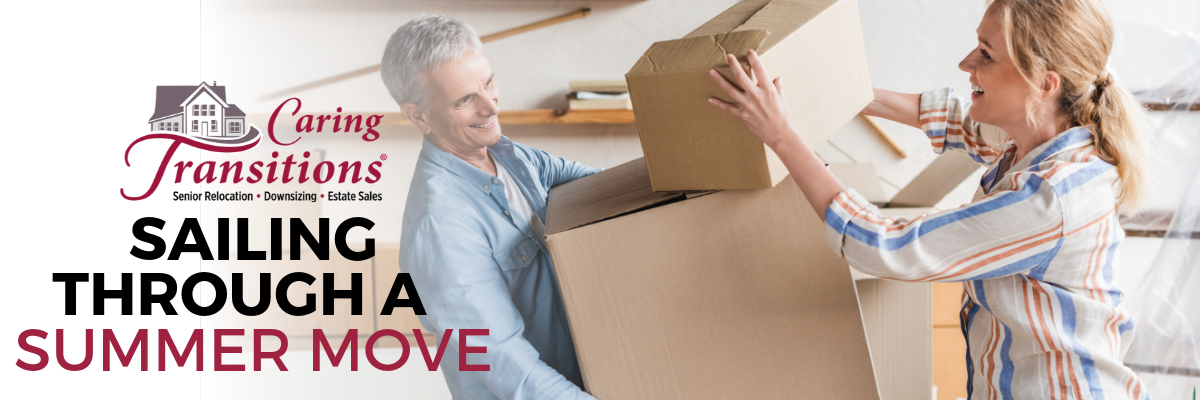
For many families, summer is the most
convenient time to move or help a loved one with a move. Since the warm weather
is attractive to most people planning moves it can make the summer move season
a bit hectic when finding resources to help facilitate your move. One way to
ease the stress of the move is creating a plan. Use our tips to make your
summer move smooth sailing.
Don’t
pack a single item, until you remove clutter BEFORE moving into your new home.
Clutter can often make the upkeep and
maintenance of any home a challenge. Add the stress of moving into a new
environment to an explosion of excess belongings, the stress of packing and
unpacking, and the worst part of moving will be intensified. Start the
process of decluttering before you pack. Decide which items are most meaningful
to you and those you need for your daily routine then identify family heirlooms
and keepsakes you are certain you want to bring to your next home. Remember to
get a firm understanding of the layout of your new home, including any limitations,
and organization wishes you have for your new space. Lastly, create a plan for
what you believe should comfortably be in each room.
Follow these steps to sort through what you
own:
- Itemize your possessions room-by-room
- Decide what can be sold or donated to a
charitable organization
- Donate or discard what haven't you used within
the last year
- Decide which items you need to schedule
estimates or appraisals for
- Decide if you should host an in-person estate
sale or online estate sale auction to sell items with a company like Caring
Transitions.
- Finally purge the identified unwanted items
according to what you planned from the previous steps
- Create an inventory list from the remaining
items for each room of your new space
Plan for utilities, services,
insurance and other related tasks weeks in advance.
You can save money on any move related services and have a firm
expectation on costs by planning ahead. According to experts, close to 70% of
moves occur between mid-May to early September. This drives demand and pricing
up on items like moving boxes, moving trucks or vans, and other move related
items. Before the move, take care of some the smaller tasks below to enjoy a
smoother move experience:
- Schedule utility service connections and
disconnections
- Collect moving supplies like boxes, tape,
packing materials, markers and other essentials
- Make insurance arrangements and notify your auto
insurance company of your new address
- Set up mail forwarding
- Make travel arrangements
Create and execute a plan for packing
over time.
Packing can be both a physical and psychological process. From
furniture pieces and photos that hold memories, to deciding what to purge, to
the labor it takes to move each item, a plan can help simplify the packing
process for anyone. Without a plan packing can seem like a daunting task that
many people put off until closer to the move. To make it less difficult create
a packing plan to efficiently save time, energy, and effort. You can make
packing simple by following these steps:
- Pack over time if you
can to make the move less stressful
- Prepare an essentials
box, weekender, or suitcase with everything you need for the first few
days in your new home. This would include toiletries, a change of clothes,
basic first aid items, bedding, cups and plates, drinks, and snacks.
- Use boxes that are the
perfect size for the items you plan to pack within it.
- Pack room-by-room and
use your inventory list as a guide for what should be packed.
- Properly label boxes
with its destination and a description.
- Put heavier items on
the bottom of the box and fill empty spaces with light items like packing
paper, clothes, towels, etc.
- Create a handle on
your boxes by cutting a hand sized triangle shaped hole on opposite sides
of the box.
- Transport important
papers, legal documents, small heirlooms and valuables personally.
Keep a positive outlook and
patiently work through the process.
Remember that any move is a process that works best with a plan and
lots of patience. When moving in the summer be sure to drink plenty of water
and try to schedule the heaviest lifting earlier or later in the day to beat
the heat.
Few if any moves occur without changing the volume of personal
possessions, or personal assets. Moving to a larger house typically triggers an
increase in furniture or belongings, while moving to a smaller one typically
generates a decrease. Whatever move you make, visualizing what you want helps
you make a conscious decision to live comfortably in the next place you plan to
call home. No matter what, take the time to evaluate the kind of experience you
want to have when preparing for your next move.